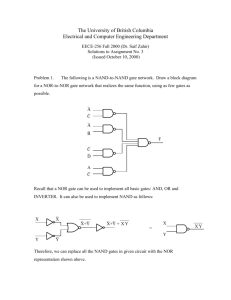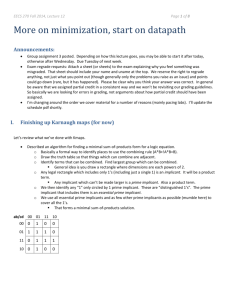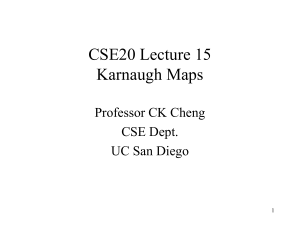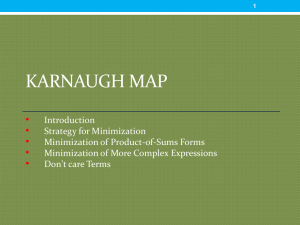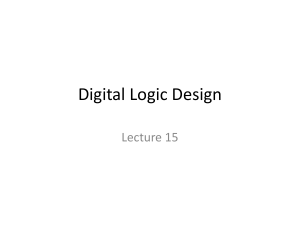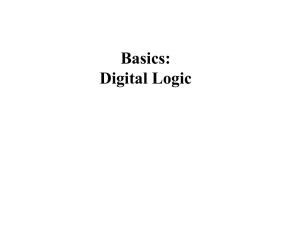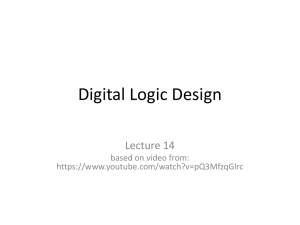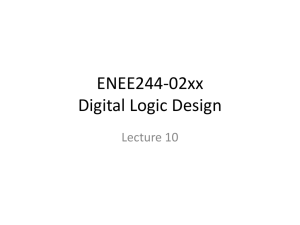PPT
advertisement
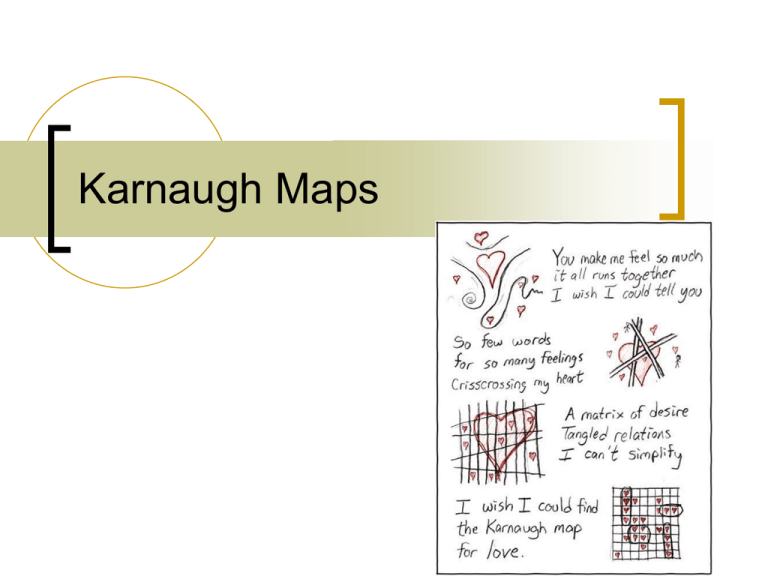
Karnaugh Maps Circuit Minimization Algebraic manipulations can be used to simplify Boolean expressions As we've seen, this process is not always easy Karnaugh maps (K-maps) provide an easy and visual technique for finding the minimum cost SOP (or POS) form for a Boolean expression This technique has limitations. i.e. works for # inputs < 7 Not good for CAD tools, but good for teaching the idea of simplification The Combining Property Recall the combining property x y + x y' = x (y + y') =x Example: f = x1'x2'x3'+x1'x2x3'+x1x2'x3'+x1x2'x3 = m0 + m2 + m4 + m5 Minterms m0 and m2 differ in only one variable (x2) m0 and m2 can be combined to get x1'x3' Reduced fan in and reduced number of gates Hence, f = x1'x3' + x1x2' still SOP but not canonical Visualizing the Combining Property f(x1,x2) = m(0,1,3) Canonical SOP: f = x1'x2'+x1'x2+x1x2 = x1'x2'+x1'x2+x1x2+x1'x2 = x1'+x2 x1 x2 F 0 0 1 0 1 1 1 0 0 1 1 1 A 2-variable Karnaugh map: x2 x1 0 1 0 1 1 1 0 1 minimum form: f = x1'+x2 3 Variable Map Gray Code: any two consecutive numbers differ in only a single bit f(A,B,C) = m(1,2,6,7) BC A 00 01 11 10 0 0 1 0 1 1 0 0 1 1 Minimum SOP is f = A B + B C' + A' B' C Cost = gates + fan-in = 4 + (7+3) = 14 K-maps in Various Sizes B 0 1 BC A 00 01 11 10 0 m0 m1 0 m0 m1 m3 m2 1 m2 m3 1 m4 m5 m7 m6 A CD AB 00 01 11 10 00 m0 m1 m3 m2 01 m4 m5 m7 m6 11 m12 m13 m15 m14 10 m8 m9 m11 m10 Full-Adder Carry-Out Cout(A,B,Cin) = m(3,5,6,7) B Cin A 00 01 11 10 0 0 0 1 0 1 0 1 1 1 Minimum SOP is Cout = A Cin + B Cin + A B Cost = 4 + 9 = 13 More 3 Variable Maps BC 00 01 11 10 0 0 0 1 1 1 1 1 0 0 BC 00 01 11 10 0 1 1 1 1 1 0 0 1 1 A f = A' B + A B' A f = A' + B (A B) And Even More 3 Variable Maps BC 00 01 11 10 0 0 1 1 0 1 1 0 0 1 BC 00 01 11 10 0 1 0 0 1 1 1 0 1 1 A f = A' C + A C' A f = C' + A B (A C) Full-Adder Sum S(A,B,Cin) = m(1,2,4,7) B Cin A 00 01 11 10 0 0 1 0 1 1 1 0 1 0 Minimum is S = A B' Cin' + A' B' Cin + A B Cin + A'B Cin' Can't reduce anything and stay in SOP form! Sidebar: Gray Codes A binary Gray code is a binary sequence such that no two consecutive numbers differ by more that a single bit Gray codes have many uses in CS 2 bit Gray code: 00, 01, 11, 10 Note that this is circular 10, 00 again differs in only 1 bit These are called binary reflected Gray codes 3 bit Gray code: 000, 001, 011, 010, 110, 111, 101, 100 Constructing Gray Codes If s0, s1, s2, …, s2n is a n bit Gray code, then we can construct an n+1 bit Gray code as follows: 0s0, 0s1, 0s2, …, 0s2n, 1s2n, 1s2n-1, 1s2n-2, …, 1s1 ,1s0 Example: 00, 01, 11, 10 00, 01, 11, 10 followed by 10, 11, 01, 00 000, 001, 011, 010 followed by 110, 111, 101, 100 Result is 000, 001, 011, 010, 110, 111, 101, 100 The Formal Karnaugh Map Method 1. 2. Choose a 1 element Find all maximal groups of 1's adjacent to that element 3. 4. Repeat steps 1-2 for all 1 elements Select all boxes for which a 1 is “covered” by only that box 5. Note: "box" must be a power of 2 in size These boxes are essential! For all 1's not covered by the essential boxes, select the smallest number of other boxes that cover them In case of a choice, select the largest box! 4 Variable Maps f(A,B,C,D) = m(0,1,2,3,6,8,9,11,13,14) CD AB 00 01 11 10 00 1 1 1 1 01 0 0 0 1 11 0 1 0 1 10 1 1 1 0 f = A C' D + B C D' + B' C ' + B' D + A'B' Another 4 Variable Map f(A,B,C,D) = m(0,1,2,5,6,7,8,9,10,13,15) These are not essential! CD AB 00 01 11 10 00 1 1 0 1 01 0 1 1 1 11 0 1 1 0 10 1 1 0 1 f = B D + A' B C + B' D' + B' C' f = B D + A' B C + B' D' + C' D or (there are 2 more) Terminology An implicant is a product term in an SOP expression (or a sum term in POS expression) Implicants are always rectangular in shape and the # of 1's covered is a power of 2 A prime implicant is an implicant that is not fully contained in some other larger implicant BC 00 01 11 10 red implicant (but not prime) many more are not shown 0 1 1 1 1 blue prime implicants (only two) 1 0 0 1 1 A Essential Prime Implicants An essential prime implicant is a prime implicant that contains a 1 not included in any other prime implicant The minimum Boolean expression must use this term A cover is a collection of implicants that accounts for all valuations in which the function is “on” (e.g. 1) Find the Essential Prime Implicants CD AB 00 01 11 10 00 1 0 0 1 01 1 1 1 1 11 1 0 1 0 10 1 0 1 1 CD AB 00 01 11 10 00 1 0 0 1 01 1 1 1 1 essential prime implicants 11 1 0 1 0 f = C'D' + A'B + B'D' + ACD 10 1 0 1 1 Don’t Care Conditions Many times there are incompletely specified conditions Modeling such a device requires us to specify don’t care conditions in those instances Valuations that can never occur, or for which we “don’t care what the device does” Use X as a value to indicate we don't care what happens Don't care situations are often called incompletely specified functions Example Using Don't Cares f(A,B,C,D) = m(1,5,8,9,10) + d(3,7,11,15) CD AB 00 01 11 10 00 0 1 X 0 01 0 1 X 0 11 0 0 X 0 10 1 1 X 1 f = A B' + A' D Karnaugh Map Method Restated 1. 2. Choose an element from the “on” set Find all maximal groups (prime implicants) of “on” elements and X elements adjacent to that element 3. 4. 5. Note 1: prime implicants are always a power of 2 in size Note 2: do not feel compelled to include X’s – use them only when they provide a larger implicant Repeat steps 1-2 for all elements in the “on” set Select all essential prime implicants For all elements of the “on” set not covered by the essential prime implicants, select the smallest number of prime implicants that cover them Example: 7 Segment Display Binary Coded Decimal (BCD) input 4 bit codes: 0000 (0) thru 1001 (9) allowed 4 bit input code should operate lights of a 7 segment display: codes 1010 – 1111 never occur 7 output signals – one for each light a a f f b WXYZ = 1001 g e b g c c d d d = 1 is optional 7 Segment Display Continued W 0 0 0 0 0 0 0 0 1 1 1 1 1 1 1 1 X 0 0 0 0 1 1 1 1 0 0 0 0 1 1 1 1 Y 0 0 1 1 0 0 1 1 0 0 1 1 0 0 1 1 Z 0 1 0 1 0 1 0 1 0 1 0 1 0 1 0 1 a 1 0 1 1 0 1 X 1 1 1 X X X X X X b 1 1 1 1 1 0 0 1 1 1 X X X X X X c 1 1 0 1 1 1 1 1 1 1 X X X X X X d 1 0 1 1 0 1 1 0 1 X X X X X X X e 1 0 1 0 0 0 1 0 1 0 X X X X X X f 1 0 0 0 1 1 1 X 1 1 X X X X X X g 0 0 1 1 1 1 1 0 1 1 X X X X X X YZ WX 00 01 11 10 00 1 0 1 1 01 0 1 1 X 11 X X X X 10 1 1 X X K-map for a a = W + Y + X'Z' + XZ Practical 7 Segment Displays The lights (LEDs) on a real 7 segment display are always “active low” When you want to use our design, just invert all the results 9 BCD = 1001 abcdefg = 111x011 becomes 000x100 a f b g e c d 5 Variable K-map YZ WX 00 01 11 10 YZ WX 00 01 11 10 00 0 0 0 0 00 0 0 1 1 01 0 X 1 1 01 0 0 X 1 11 1 1 0 X 11 1 1 X X 10 1 1 0 X 10 X 1 X X V=0 V=1 f = WY' + W'XY + VY POS Minimization K-maps can be used for POS minimization, too f(A,B,C) = m(2,3,6) BC A 00 01 11 10 0 0 0 1 1 1 0 0 0 1 Minimum POS is f = (B)(A' + C') Minimum SOP is f = A'B + BC' cost = 2 + 4 = 6 cost = 3 + 6 = 9 SOP vs POS Minimization CD AB 00 01 11 10 CD AB 00 01 11 10 00 0 1 X 0 00 0 1 X 0 01 0 1 X 0 01 0 1 X 0 11 1 1 X 0 11 1 1 X 0 10 1 1 X 1 10 1 1 X 1 SOP f = D + AC' + AB' cost = 3 + 7 = 10 POS f = (A + D)(B' + C') cost = 3 + 6 = 9 Multiple Output Problems Multiple Output Circuits Multiple outputs circuits can be designed … using two separate systems, or using one combined system that may share gates A B C F A B C G A B C F G Gate Sharing When there are multiple outputs, gate sharing is sometimes possible CD AB 00 01 11 10 CD AB 00 01 11 10 00 0 0 1 1 00 0 0 1 1 01 0 1 1 1 01 0 0 1 1 11 1 1 0 0 11 1 1 1 0 10 1 1 0 0 10 1 1 0 0 f = AC' + A'C + A'BD g = AC' + A'C + ABD Gate Sharing Can Be Easy … f = AC' + A'C + A'BD g = AC' + A'C + ABD This is an obvious use of gate sharing Gate Sharing Can Be Less Obvious BC A 00 01 11 10 BC A 00 01 11 10 0 1 0 1 0 0 0 1 1 0 1 1 0 0 0 1 0 1 0 0 f = B'C' + A'BC g = B'C + A'C, or g = B'C + A'BC By choosing an implicant that was non-prime, we get an overall cost that is less (due to sharing) non-shared cost = (3 + 7) + (3 + 6) = 19 shared cost = (3 + 7) + (2 + 4) = 16 Implemented Gate Sharing shared gate not from a prime implicant Gate Sharing Can Be Hard! CD AB 00 01 11 10 CD AB 00 01 11 10 00 0 0 0 0 00 0 0 0 0 01 0 0 1 1 01 1 1 1 1 11 1 1 0 1 11 0 1 1 0 10 1 0 0 1 10 0 0 1 0 Look for the 1's that are not 1's for the other function Cover them with prime implicants Then look for shared terms still implicants, but not necessarily prime Another Example … Note that minterm m1 can be covered by 2 possible prime implicants – choose based on gate sharing CD AB 00 01 11 10 CD AB 00 01 11 10 00 0 1 1 1 00 1 0 0 0 01 0 1 1 0 01 0 1 1 0 11 0 0 0 0 11 0 1 1 0 10 0 1 0 0 10 1 1 1 0 Cost Saving Based on sharing: f = A'B'C + B'C'D + A'BD g = B'C'D' + AD + A'BD shared cost = 7 + 20 = 27 Individually: f = A'B'C + B'C'D + A'D g = B'C'D' + AD + BD cost = (4 + 11) + (4 + 10) = 29 Gate Sharing With Don't Cares shared implicant CD AB 00 01 11 10 CD AB 00 01 11 10 00 X 1 1 0 00 X 0 1 0 01 X 0 0 1 01 X 0 0 0 11 1 0 X 1 11 0 0 X 1 10 1 1 X 0 10 1 1 X 1 f = BD' + B'CD + B'C' g = AC + B'CD + AB' cost = (4 + 10) + (3 + 7) = 24 Alternate Solution CD AB 00 01 11 10 CD AB 00 01 11 10 00 X 1 1 0 00 X 0 1 0 01 X 0 0 1 01 X 0 0 0 11 1 0 X 1 11 0 0 X 1 10 1 1 X 0 10 1 1 X 1 f = BD' + B'D + AB'C' g = AC + B'CD + AB'C' cost = (4 + 10) + (3 + 8) = 25


